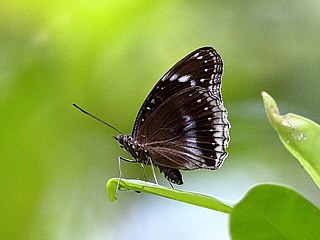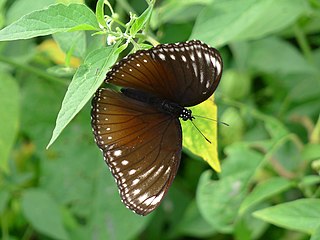
Hypolimnas is a genus of tropical brush-footed butterflies commonly known as eggflies or diadems. The genus contains approximately 23 species, most of which are found in Africa, Asia, and Oceania. One species, the Danaid eggfly, is noted for its exceptionally wide distribution across five continents; it is the only Hypolimnas species found in the Americas.

Hypolimnas bolina, the great eggfly, common eggfly, varied eggfly, or in New Zealand the blue moon butterfly, is a species of nymphalid butterfly found from Madagascar to Asia and Australia.

Jamides, commonly called ceruleans, is a genus of butterflies in the family Lycaenidae. The species of this genus are found in the Indomalayan realm, the Palearctic realm and the Australasian realm.

Athyma is a genus of brush-footed butterflies. They are commonly known as the "true" or "typical" sergeants, to distinguish them from the false sergeants of the genus Pseudathyma, a fairly close relative from the Adoliadini tribe. The genus ranges from Tibet to the Solomon Islands, but does not occur in New Guinea or Australia.

Hypolimnas alimena, the blue-banded eggfly, is a species of butterfly in the family Nymphalidae. It is found in the Solomon Islands, Indonesia, New Guinea and Australia.

Taenaris is a genus of butterflies in the family Nymphalidae, subfamily Amathusiinae, that distributed throughout Australasia with a majority of species being located on the island of New Guinea. They are commonly known as the owl butterflies.

Hypolimnas anomala, commonly known as the Malayan eggfly or crow eggfly, is a species of eggfly.

Tirumala hamata, the dark tiger, is a butterfly of the family Nymphalidae. It is distributed from the Philippines to Australia and Pacific oceanic islands such as Samoa. In Australia, the butterflies perform mass migrations to the south in some years. In April 1995, the butterfly made a rare migratory journey to New Zealand, coinciding with the appearance of Hypolimnas bolina on the islands.

Curetis barsine is a species of butterfly belonging to the lycaenid family. It is found in the Australasian realm.

Euploea phaenareta, the giant crow is a butterfly in the family Nymphalidae. It was described by Johann Gottlieb Schaller in 1785. It is found in the Indomalayan realm and the Australasian realm.

Euploea stephensii is a butterfly in the family Nymphalidae. It was described by Cajetan Felder and Rudolf Felder in 1865. It is found in the Australasian realm.












